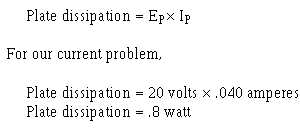1-17
You should note that there is very little difference in plate resistance when the Ep and Ip values are
taken from the linear portions of curves. Check this out with values taken from the linear portion of figure
1-13.
Rp (with a capital R) is the effective resistance offered to direct current.
PLATE RESISTANCE IN GAS DIODES.—Gas diodes are a type of tube that we have not yet
discussed. They are mentioned here only because of their plate-resistance characteristic.
Instead of a high-vacuum environment, some tubes have small amounts of gas introduced in the
envelope vacuum during manufacture. Argon, neon, helium, or mercury vapor are commonly used.
When a certain minimum voltage is placed on the plate, the gas molecules in the envelope ionize.
This happens by a process that will be explained when gas diodes are studied. The positive ions tend to
cancel some of the effects of the space charge that influence plate resistance in a vacuum tube. This
canceling reduces internal plate resistance to a relatively low, constant value. In applications that require a
large plate current, the low plate resistance of a gas-filled diode has an efficiency that cannot be
approached by a high-vacuum diode.
This and other characteristics of gas tubes will be covered later.
Q10.
Vacuum tubes are designed to operate in what portion of the Ep - Ip curve?
Q11.
What value can be calculated from the values found on an Ep - Ip curve?
Plate Dissipation
When electrons are attracted from the space charge to the plate, they are accelerated by the
attraction. Their gain in speed gives them energy that causes them to strike the plate with a considerable
force. As the electrons strike the plate, this energy is converted to heat. The plate must be able to
withstand the associated increase in temperature. The maximum amount of power (watts) that a given
plate can safely dissipate (as heat) is called the PLATE DISSIPATION rating.
To find the amount of plate dissipation for a given tube under a particular set of plate conditions, use
the following equation:
This is a relatively small wattage. It's probable that the plate of our example diode is not overheating.
A tube manual could tell us for sure.
Plate dissipation is a circuit loss that must be made good by the power source in a circuit. In our
example, this is the plate voltage supply.

